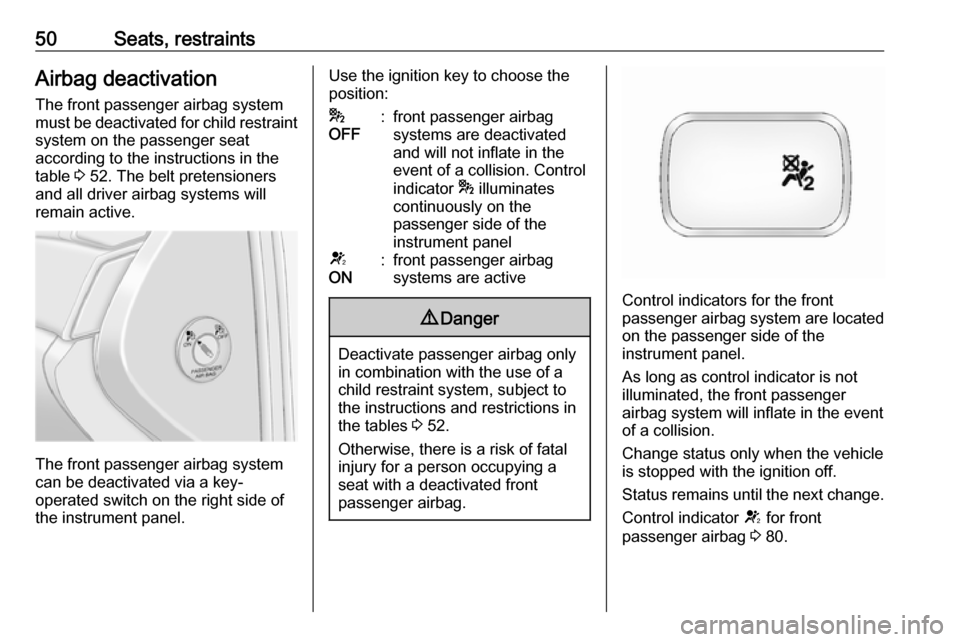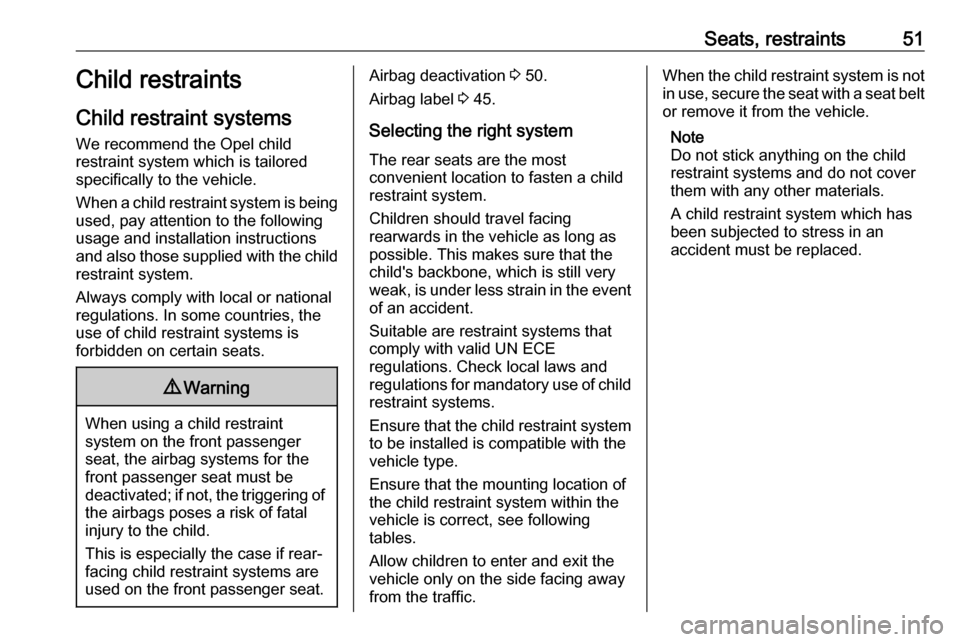OPEL ANTARA 2017.5 Manual user
Manufacturer: OPEL, Model Year: 2017.5, Model line: ANTARA, Model: OPEL ANTARA 2017.5Pages: 225, PDF Size: 6.2 MB
Page 51 of 225

Seats, restraints49The side airbag system consists of an
airbag in each front seat backrest.
This can be identified by the word
AIRBAG .
The side airbag system is triggered in
the event of a side impact of a certain severity. The ignition must be
switched on.
The inflated airbags cushion the
impact, thereby considerably
reducing the risk of injury to the upper body and pelvis in the event of a side-
on collision.
9 Warning
Keep the area in which the airbag
inflates clear of obstructions.
Note
Only use protective seat covers that have been approved for the vehicle.Be careful not to cover the airbags.
Curtain airbag system
The curtain airbag system consists of an airbag in the roof frame on each
side. This can be identified by the
word AIRBAG on the roof pillars.
The curtain airbag system is triggered
in the event of a side-on impact of a
certain severity. The ignition must be
switched on.
The inflated airbags cushion the
impact, thereby considerably
reducing the risk of injury to the head in the event of a side-on impact.
9 Warning
Keep the area in which the airbag
inflates clear of obstructions.
The hooks on the handles in the
roof frame are only suitable for
hanging up light articles of
clothing, without coat hangers. Do not keep any items in these
clothes.
Page 52 of 225

50Seats, restraintsAirbag deactivation
The front passenger airbag system
must be deactivated for child restraint system on the passenger seat
according to the instructions in the
table 3 52. The belt pretensioners
and all driver airbag systems will
remain active.
The front passenger airbag system
can be deactivated via a key-
operated switch on the right side of
the instrument panel.
Use the ignition key to choose theposition:*
OFF:front passenger airbag
systems are deactivated
and will not inflate in the
event of a collision. Control
indicator * illuminates
continuously on the
passenger side of the
instrument panelV
ON:front passenger airbag
systems are active9 Danger
Deactivate passenger airbag only
in combination with the use of a
child restraint system, subject to
the instructions and restrictions in
the tables 3 52.
Otherwise, there is a risk of fatal
injury for a person occupying a
seat with a deactivated front
passenger airbag.
Control indicators for the front
passenger airbag system are located
on the passenger side of the
instrument panel.
As long as control indicator is not
illuminated, the front passenger
airbag system will inflate in the event
of a collision.
Change status only when the vehicle
is stopped with the ignition off.
Status remains until the next change.
Control indicator V for front
passenger airbag 3 80.
Page 53 of 225

Seats, restraints51Child restraints
Child restraint systems
We recommend the Opel child
restraint system which is tailored
specifically to the vehicle.
When a child restraint system is being used, pay attention to the following
usage and installation instructions
and also those supplied with the child
restraint system.
Always comply with local or national
regulations. In some countries, the
use of child restraint systems is
forbidden on certain seats.9 Warning
When using a child restraint
system on the front passenger
seat, the airbag systems for the
front passenger seat must be
deactivated; if not, the triggering of the airbags poses a risk of fatal
injury to the child.
This is especially the case if rear-
facing child restraint systems are
used on the front passenger seat.
Airbag deactivation 3 50.
Airbag label 3 45.
Selecting the right system The rear seats are the most
convenient location to fasten a child
restraint system.
Children should travel facing
rearwards in the vehicle as long as
possible. This makes sure that the
child's backbone, which is still very
weak, is under less strain in the event of an accident.
Suitable are restraint systems that
comply with valid UN ECE
regulations. Check local laws and
regulations for mandatory use of child restraint systems.
Ensure that the child restraint system
to be installed is compatible with the
vehicle type.
Ensure that the mounting location of
the child restraint system within the
vehicle is correct, see following
tables.
Allow children to enter and exit the
vehicle only on the side facing away
from the traffic.When the child restraint system is not in use, secure the seat with a seat beltor remove it from the vehicle.
Note
Do not stick anything on the child
restraint systems and do not cover
them with any other materials.
A child restraint system which has
been subjected to stress in an
accident must be replaced.
Page 54 of 225

52Seats, restraintsChild restraint installation locations
Permissible options for fitting a child restraint system
Weight and age class
On front passenger seat
On rear outboard seatsOn rear centre seat
activated airbagdeactivated airbagGroup 0: up to 10 kg
or approx. 10 monthsXU 1U,
or approx. 6 to 12 yearsXXUX1:Child restraint system must be secured using a three-point seat belt. Move seat height adjustment to uppermost
position and ensure that vehicle seat belt runs forwards from the upper anchorage point. Adjust seat backrest
inclination as far as necessary to a vertical position to ensure that the belt is tight on the buckle side.<:Vehicle seat with ISOFIX mounting available. When mounting with ISOFIX, only ISOFIX child restraint systems that
have been approved for the vehicle may be used.U:Universal suitability in conjunction with three-point seat belt.X:No child restraint system permitted in this weight and age class.
Page 55 of 225

Seats, restraints53Permissible options for fitting an ISOFIX child restraint systemWeight and age classSize classFixtureOn front
passenger seatOn rear
outboard seatsOn rear
centre seatGroup 0: up to 10 kg or approx. 10 monthsEISO/R1XILXGroup 0+: up to 13 kg or approx. 2 yearsEISO/R1XILXDISO/R2XILXCISO/R3XILXGroup I: 9 to 18 kg or approx. 8 months to 4 yearsDISO/R2XILXCISO/R3XILXBISO/F2XIUFXB1ISO/F2XXIUFXAISO/F3XIUFXGroup II: 15 to 25 kg
or approx. 3 to 7 yearsXILXGroup III: 22 to 36 kg
or approx. 6 to 12 yearsXILX
Page 56 of 225

54Seats, restraintsIL:Suitable for particular ISOFIX restraint systems of the 'vehicle-specific', 'restricted' or 'semi-universal' categories.The ISOFIX restraint system must be approved for the specific vehicle type.IUF:Suitable for ISOFIX forward-facing child restraint systems of universal category approved for use in this weight and
age class.X:No ISOFIX child restraint system approved in this weight and age class.
ISOFIX size class and seat device
A - ISO/F3:Forward-facing child restraint system for children of maximum size in the weight class 9 to 18 kg.B - ISO/F2:Forward-facing child restraint system for smaller children in the weight class 9 to 18 kg.B1 - ISO/F2X:Forward-facing child restraint system for smaller children in the weight class 9 to 18 kg.C - ISO/R3:Rear-facing child restraint system for children of maximum size in the weight class up to 18 kg.D - ISO/R2:Rear-facing child restraint system for smaller children in the weight class up to 18 kg.E - ISO/R1:Rear-facing child restraint system for young children in the weight class up to 13 kg.
Page 57 of 225

Seats, restraints55ISOFIX child restraintsystems
Fasten vehicle-approved ISOFIX
child restraint systems to the ISOFIX
mounting brackets.
Permitted installation positions for specific vehicle ISOFIX child restraint
systems are marked in the table by IL.
No more than two ISOFIX child
restraint systems can be installed on
the rear seats at the same time,
though not on the rear centre seat.
ISOFIX mounting brackets are
indicated by a label on the backrest.
Top-tether fastening eyes
The Top-tether anchors located on
the rear of the backrests are designed
to hold child restraints which come
equipped with Top-tether anchor
attachments only. Follow the
instructions provided with the
Top-tether child restraint system.
For use of ISOFIX and Top-tether
fixings, universal ISOFIX child restraint systems may be used.
Permitted installation positions are
marked in the table by IUF.
Page 58 of 225

56StorageStorageStorage compartments................56
Instrument panel storage ...........56
Glovebox ................................... 57
Cupholders ................................ 57
Sunglasses storage ...................57
Underseat storage .....................57
Armrest storage .........................58
Centre console storage .............58
Rear carrier system ...................58
Load compartment .......................67
Load compartment cover ...........67
Rear floor storage cover ............68
Lashing eyes ............................. 69
Warning triangle ........................69
First aid kit ................................. 69
Fire extinguisher ........................69
Roof rack system .........................69
Roof rack ................................... 69
Loading information .....................70Storage compartments9Warning
Do not store heavy or sharp
objects in the storage
compartments. Otherwise vehicle
occupants could be injured by
objects being thrown around in the
event of hard braking, a sudden
change in direction or an accident.
Instrument panel storage
Console net
Located in the front passenger foot
well.
Coin storage
Pull handle to open. Push door firmly
to close.
Card holder Located above the coin storage
compartment. A card can be retained
in the slot for convenient use.
Page 59 of 225

Storage57Glovebox
The glovebox will illuminate when
opened.
The glovebox partition can be
removed from its groove. Store the
partition in the groove on the far left- hand side of the glovebox.
The glovebox should be closed whilst driving.
Lockable glovebox Lock and unlock the glovebox with thekey.
Cupholders
Cupholders are located in the front ofthe centre console.
The cupholder is flexible, allowing
different size drink containers to be
stored.
Additional cupholders are located in
the centre rear seat armrest. Fold
down the armrest to access the
cupholder.
Sunglasses storage
To open: push the rear part of the
cover.
To close: pull up cover and push it
until it latches into place.
Do not use for storing heavy objects.
Underseat storage Front passenger seat undertray
Pull up on front of tray then pull it
forwards. Push the tray towards the
seat to return it to its original position.
Page 60 of 225

58StorageArmrest storage
Console box in front armrest
To open: pull up lever and lift the lid.
To close: lower lid and push it down
until it latches into position.
Centre console storage To access the storage compartment,
power outlet and AUX input, slide the
cupholder tray rearwards.
Power outlets 3 77.
AUX input - see Infotainment system
manual for further information.
Rear carrier system
The rear carrier system (Flex-Fix
system) allows bicycles to be
attached to a pull-out carrier
integrated into the vehicle floor. The
transportation of other objects is not
permitted.
The maximum load of the rear carrier
system is 40 kg. The maximum load
per bicycle is 20 kg.
The wheelbase of a bicycle must not
exceed 1.2 metres. Otherwise the
secure fastening of a bicycle is not possible.
If not in use, the carrier system must
be slid back into the vehicle floor.
A multifunction box is offered as an
accessory for the rear carrier system.
There must not be any objects on thebicycles that could become loose
during transportation.Caution
If the rear carrier system is
extended and the vehicle is fully
loaded, the chassis clearance will
be reduced.
Drive carefully whenever the road has a strong inclination or when
driving over a ramp, bump, etc.
Caution
Do not attach bicycles with carbon pedal cranks to bicycle carriers.
The bicycles might get damaged.
Extending
Open the tailgate.